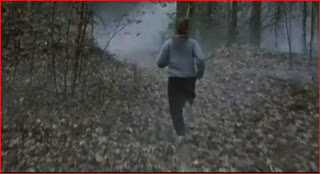1. In what ways does your media product use, develop or challenge forms and conventions of real media products?
- Our thriller sequence 'Omniscient' uses various elements to develop and challenge forms and conventions of real media products through the technical codes; mise en scene, sound, editing, and camera work. We also thought about iconography - such as the gun, restricted narration, binary oppositions, ect. The main aim we had when producing our thriller sequence was for elements in the story to remain unknown, creating irony as the title is 'Omniscient'. We met our aim by using restricted narration, keeping the character on the other side of the phone call a secret, and through the use of shared context between the characters as the spectator doesn't know the background story of who the person on the phone has taken, and why.

This is the gun used by the protagonist in our thriller sequence. It is iconography used frequently in many thrillers as it creates enigma. It also gains an immediate reaction from the audience as so familiar to them from it's stereotypical use in various thriller film. However, we tried to challenge conventions of real media products by using a sound bridge of the gun shot, rather then the spectator seeing the gun being shot and whose shooting it.

This shot was inspired by 'Zodiac', because it created such an intense scene full of enigma. However, we challenged this by having the end of the rifle pointed towards the camera, so that it was closer in the frame giving the sense that its pointed at the spectator, whereas in the screen grab from 'Zodiac', the gun is further away meaning there's less of it in the frame.
- Similarly to the thriller 'Zodiac', our thriller sequence also had a scene of a POV shot from inside a car window driving past houses. This creates enigma for the spectator as you can't see who is in the car (restricted narration) and whether they're an antagonist/protagonist. However, the lighting at this scene in 'Zodiac' is very dark and mysterious which is suitable iconography for a thriller; whereas in our thriller sequence the lighting is dull and faded as opposed to dark - which adds mystery.
- Enigma is created through other technical codes such as sound. We used a non-diegetic soundtrack to accompany the sequence which started slow in pace and accelerated as it builds up as the sequence begins; creating suspense, unlike other thrillers I researched such as Seven. In the thriller Seven, the non-diegetic use of music is very creepy and intense. We also used a sound bridge when the male character, the antagonist, gets an unknown phone call. By using the sound bridge , enigma is created because the spectator isn't aware of who is on the other side of the phone call.
- Enigma is also portrayed through the introduction of the protagonist. The identity of the protagonist isn't fully known, due to the lighting. This creates spectator positioning because it causes the spectator to wonder who the character is, what their purpose is and whether their the antagonist or protagonist. However, we used mise en scene and iconography for a thriller to hint to the audience that the character is the protagonist. The spectator can see that he is male - male protagonist's are highly popular amongst thriller films therefore it fits the stereotype. The setting is very dark, with minimal colour and the lighting is being presented from a low angle on to the bottom of the protagonists face in order for the outline of his face to be visible - conveying a mysterious, eerie atmosphere. Also, the protagonist is smoking which is iconography often associated with protagonists in the thriller genre.

- Restricted narration is used in our main task, something used in many thriller films. We used this to mask the true identity of the protagonist in order to create enigma and spectator positioning. The screen grabs below show how we used restricted narration, and how it was used in 'The Usual Suspects'. We used the rifle (prop) to hide the face of the protagonist whereas in 'The Usual Suspect' they used composition, only showing the bottom half of the character in the frame.

- I researched the thriller opening to 'Silence of the Lambs' which has a similar setting as Omniscient - a forest. The scene in our thriller sequence where the antagonist is running in the forest through the trees is fairly similar to a scene in 'Silence of the Lambs'. I felt that this scene is full of suspense and leaves the spectator drawn to the scene, therefore wanted to incorporate it in our thriller.





No comments:
Post a Comment